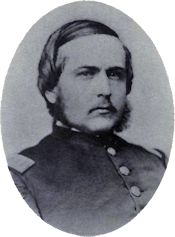Monday, May 30th.
The artillery and our battalions advanced at 4 o’clock A. M., something like half a mile to a point near Totopotomoy creek, where we stacked arms in a road and a cornfield of fifty acres, or thereabouts, and threw up earthworks for the artillery within two or three hundred yards of the enemy’s line under a galling fire of musketry. The rebels in our front were busily at work also building earthworks, and at noon they opened a brisk artillery fire. Immediately in the rear of my company as it was at work on the breast-works, stood a fine large brick or stone house with a slate roof, known as the Shelton House, which was said to belong to a rebel Colonel then in the works, in front of us, and was occupied by some ladies of his family, who had, however, very properly taken refuge in the cellar. Between our works and the house, which stood with its rear towards us, was a semi-circle of negro quarters, and in front of these little frame and log houses the artillerymen had backed up their caissons and ammunition wagons to conceal them as much as possible from the enemy. At the door of one of these cabins was a large pile of ashes, where the old “mammy” who lived there had emptied the contents of her stove for years, and as the men took out the ammunition from the chest on a limber, considerable powder was sprinkled on this dumping ground. Not long after the rebels had commenced firing, and after they had sent several rifled projectiles through the main house and its roof, and had split some of the great trees standing close by, the old darkey woman came to her door, cool as a cucumber, and apparently oblivious of the danger of her act, threw a shovel full of hot ashes and coals just out of her stove squarely under the limber, and instantly the front of that shanty was taken off as cleanly as if cut down by a monster hay-knife. Two men were killed and several wounded, but the negress is said to have escaped unhurt. A tremendous cheer at once rang out from the rebel line, the occupants of which no doubt supposed that the explosion of the limber chest had been caused by one of their shells. After getting our guns in position we opened on them, and the cannonading was vigorously kept up all along the line until dark. Co. D., Capt. Jones, was to-day detailed to man a Coehorn Mortar Battery.



